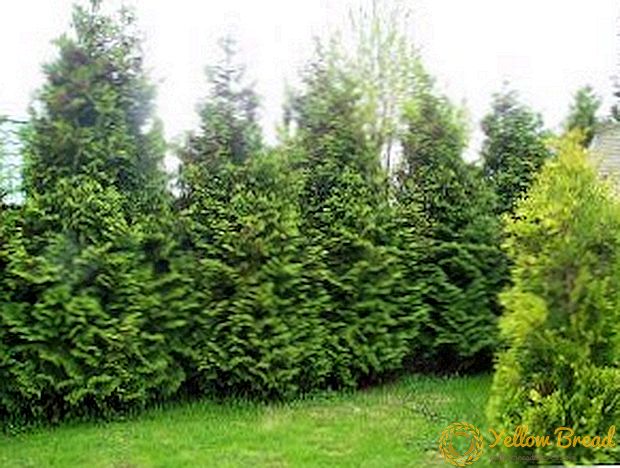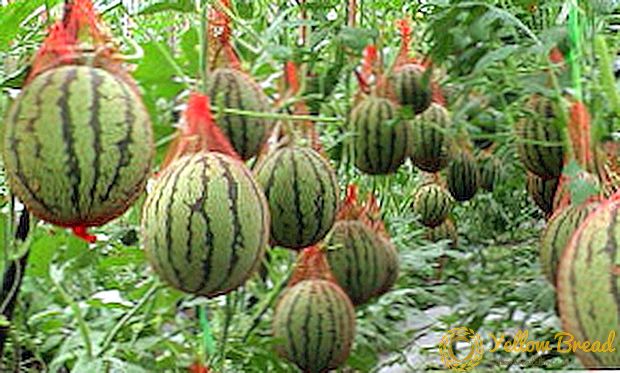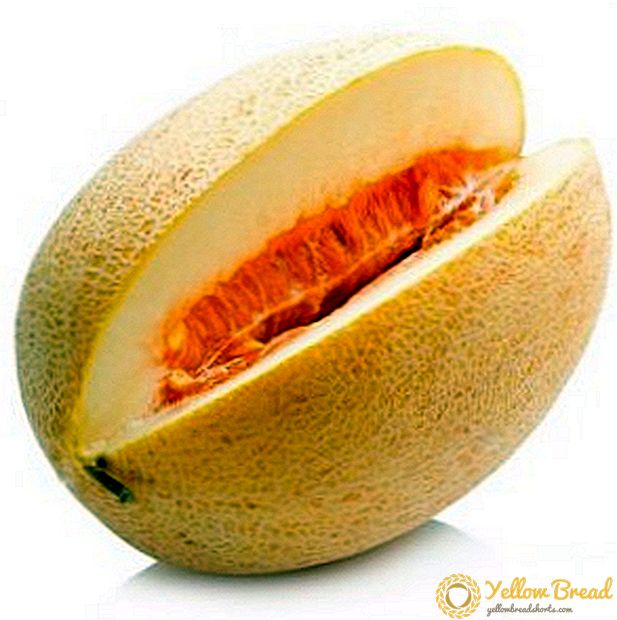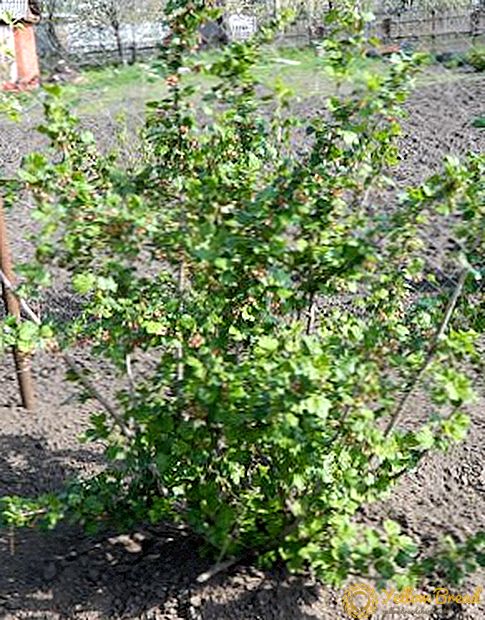 One of the popular evergreens is thuja. It is planted in parks, alleys, decorate the area near the administrative buildings, often planted in the dacha or garden plots. Unfortunately, thuja is prone to diseases and pests, how to deal with them, we consider in this article.
One of the popular evergreens is thuja. It is planted in parks, alleys, decorate the area near the administrative buildings, often planted in the dacha or garden plots. Unfortunately, thuja is prone to diseases and pests, how to deal with them, we consider in this article.
- How to deal with diseases of Tui
- Brown shoots
- Rust
- Schutte
- Phytophthora
- Tinder mushroom
- Shrinking shoots and branches
- How to deal with Tui pests
- Weevils
- Spider mite
- Wireworms
- Tuevaya pseudo shield
- Tuva beetle
- Thuja motley moth
- Tuevaya aphid
How to deal with diseases of Tui
It is possible to fight tui diseases, but it is better to prevent them. For thuja need proper care: watering, feeding, pruning, weeding. Many diseases develop in a humid environment, so when watering it is important not to overdo it, usually watering is carried out once a week.
 As for fertilizing, organic fertilizers such as fresh manure and chicken droppings are contraindicated. In fresh organic fertilizers there are too many living microorganisms that can lead to serious illness. It is imperative to clear the near-stem circle of weeds, which can also cause an infection or an invasion of parasites. In the treatment of plant diseases, fungicides and bordeaux preparations are used.
As for fertilizing, organic fertilizers such as fresh manure and chicken droppings are contraindicated. In fresh organic fertilizers there are too many living microorganisms that can lead to serious illness. It is imperative to clear the near-stem circle of weeds, which can also cause an infection or an invasion of parasites. In the treatment of plant diseases, fungicides and bordeaux preparations are used.
From pests get rid of with the help of insecticides, also use traditional methods. In case of severe damage to individual parts of the plant, they must be removed and disposed of. In principle, almost all diseases can be cured by detecting them at an early stage.
Brown shoots
Brown shoots are a fungal infection, its symptoms appear in early spring. The fungus often hibernates in the remains of vegetation and in the soil, therefore it is necessary to thoroughly clean the site for the winter. When a thuja is damaged, the scales of the bark begin to turn yellow, the disease gradually affects the shoots, and they die off.
Owners of sites on which coniferous grow, have to know, than to treat a thuja from a fungus. The best antifungal agent is "Fundazol". A two-percent solution of the plant is sprayed in the summer-autumn period to the month of October inclusive. Affected branches must be removed. To protect the thuja from the fungus, sprinkle the roots of the plant with limestone.
Rust
 Rust - a disease of young plants, the causes of the disease can be several: high humidity, lack of food, hot weather and dry air. As a preventive measure, all conifers are sprayed on the site in the spring. Spraying is carried out with the preparation "HOM" (40 g per 10 liters of water), the diseased parts of the thuja are removed. If the disease cannot be localized, treat with Fundazole (20 g per 10 liters).
Rust - a disease of young plants, the causes of the disease can be several: high humidity, lack of food, hot weather and dry air. As a preventive measure, all conifers are sprayed on the site in the spring. Spraying is carried out with the preparation "HOM" (40 g per 10 liters of water), the diseased parts of the thuja are removed. If the disease cannot be localized, treat with Fundazole (20 g per 10 liters).
Schutte
Shutte is a fungal disease, its symptoms are darkened and falling needles. Schutte, like rust, affects mainly young trees. The reason is lack of nutrition and improper care. The treatment is carried out by spraying a solution of the drug "Topsin-M" (15 g per 10 liters of water). Processing is carried out not earlier than the threat of winter frosts. Spraying a thuja with Bordeaux liquid is considered very effective against fungi; you can buy it at any flower shop.
Phytophthora
 The most dangerous fungal disease for tui on the plot is phytophtora. The reason for its occurrence is often the proximity of groundwater or poor soil drainage. The fungus settles on the roots of the plant and gradually affects the entire tree. The trunk closer to the surface becomes loose, the needles and bark change color to gray, and over time the tree dies. Fungicides are used for prophylaxis; it will not be possible to cure phytophthora with the defeat of the root system - it is better to dig and burn the plant. Spores of the fungus live for a long time in the soil, so the soil needs to be replaced or disinfected.
The most dangerous fungal disease for tui on the plot is phytophtora. The reason for its occurrence is often the proximity of groundwater or poor soil drainage. The fungus settles on the roots of the plant and gradually affects the entire tree. The trunk closer to the surface becomes loose, the needles and bark change color to gray, and over time the tree dies. Fungicides are used for prophylaxis; it will not be possible to cure phytophthora with the defeat of the root system - it is better to dig and burn the plant. Spores of the fungus live for a long time in the soil, so the soil needs to be replaced or disinfected.
Tinder mushroom
Tinder fungus strikes thuja through mechanical damage or dried bitches. Spores penetrate the plant tissue, forming a kind of growths - the fruiting body of the fungus. The thuja dries and turns yellow. Mushroom growths, all affected and yellowed parts of the thuja should be cut off. Cleaned and cleaned wounds with special putty. Spray the plant itself with a solution of Bordeaux liquid. Preventive spraying is carried out in the spring and autumn periods.
Shrinking shoots and branches
 If the thuja has turned yellow and began to dry out, but there are no visible reasons, what to do about it? Most likely, the cause is root fusarium. This fungus infects the root system, so it is not immediately noticeable, the shoots first dry, and then the whole tree. Crown and roots under a bush watered with systemic fungicides. Since the fungus appears in weakened plants with a lack of nutrition, it is necessary to feed this fertilizer with fertilizer, which contains a large amount of copper or iron.
If the thuja has turned yellow and began to dry out, but there are no visible reasons, what to do about it? Most likely, the cause is root fusarium. This fungus infects the root system, so it is not immediately noticeable, the shoots first dry, and then the whole tree. Crown and roots under a bush watered with systemic fungicides. Since the fungus appears in weakened plants with a lack of nutrition, it is necessary to feed this fertilizer with fertilizer, which contains a large amount of copper or iron.
How to deal with Tui pests
Tui have many pests, insects affect both above-ground parts and the roots of the plant, in addition, they lay off their offspring, which also destroys the tree.
Weevils
Adult weevils feed on the bark of young shoots, and their larvae destroy the root system. Subsequently, the tips of the branches of the thuja become brown. Favorable habitat for weevils is acidic and moist soil. It is possible to destroy parasites with the help of insecticides, and it is necessary to lime the soil if it has an acid reaction.
Spider mite
 Spider mite likes dryness. This parasite is dangerous because it multiplies rapidly, entangling the web with all the trees. The result was that the thuja needles turned yellow and crumbled, let's see what to do in this case.With a strong lesion is better to handle drugs - acaricides. If you noticed the web in time, you can get away with folk remedies: sprinkle with garlic or dandelion infusion. In addition, spray with plain clean water: the mite does not like moisture.
Spider mite likes dryness. This parasite is dangerous because it multiplies rapidly, entangling the web with all the trees. The result was that the thuja needles turned yellow and crumbled, let's see what to do in this case.With a strong lesion is better to handle drugs - acaricides. If you noticed the web in time, you can get away with folk remedies: sprinkle with garlic or dandelion infusion. In addition, spray with plain clean water: the mite does not like moisture.
Wireworms
Wireworms - beetles, often black, humus attracts them to the site. These parasites gnaw up the roots. The larvae of beetles feed on bark scales and tissues of young shoots. Often, the larvae live in areas with stagnant moisture. Prevention is good drainage in the soil and liming with acidic soil. With a large accumulation of pests, the soil is treated with preparations containing diazolin.
Tuevaya pseudo shield
 Thuja pseudo-shield hits the bark with yellow fast-growing ulcers. If time does not get rid of the pest - the whole trunk will turn yellow, and the thuja will die. The following medications are used against false shields: Actellic, Antio, Karbofos, Rogor. Folk remedies: soap solution on alcohol (15 g of soap, 10 ml of denatured alcohol, 1 l of water); applying glue from the caterpillars and larvae to the bark of the tree.
Thuja pseudo-shield hits the bark with yellow fast-growing ulcers. If time does not get rid of the pest - the whole trunk will turn yellow, and the thuja will die. The following medications are used against false shields: Actellic, Antio, Karbofos, Rogor. Folk remedies: soap solution on alcohol (15 g of soap, 10 ml of denatured alcohol, 1 l of water); applying glue from the caterpillars and larvae to the bark of the tree.
Tuva beetle
Tuva beetle damages the bark of the tree, leaving holes-moves. The parasite can be grabbed with a sapling when buying, so carefully inspect the planting material. The appearance of the pest happens with improper care, lack of nutrition for young plants. You can get rid of it by spraying with insecticides. As a preventive treatment, treat the thuja with Bordeaux liquid in the spring.
Thuja motley moth
Thug moth gnaws young shoots of trees, small larvae up to 4 mm. With the defeat of the shoots die off. Twice spraying with Tornado, Moskitol, Fumitoks (seven days interval) will help fight the parasite. Branches affected by moths must be removed.
Tuevaya aphid
 If the thuja dries and the needles turn yellow, what to do about it and what are the reasons? The reason is tuevoy aphid. These small insects settle on thuja's needles, feeding on its sap. Most often affected shoots that grow above the ground. The most effective method of aphids - processing "Malophos".
If the thuja dries and the needles turn yellow, what to do about it and what are the reasons? The reason is tuevoy aphid. These small insects settle on thuja's needles, feeding on its sap. Most often affected shoots that grow above the ground. The most effective method of aphids - processing "Malophos".
To summarize: prevention and timely, proper care - the guarantee of health of your plant. If the thuja is showered or the tips of the shoots turn yellow, do not rush to panic. Inspect the plant carefully, often this is due to the preparation of the thuja for the winter period, and not with the disease or the attack of insects.






